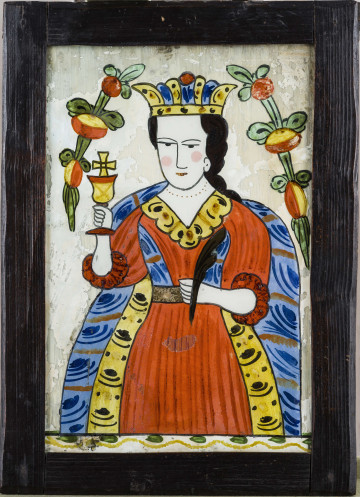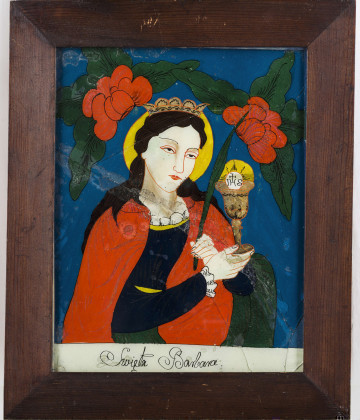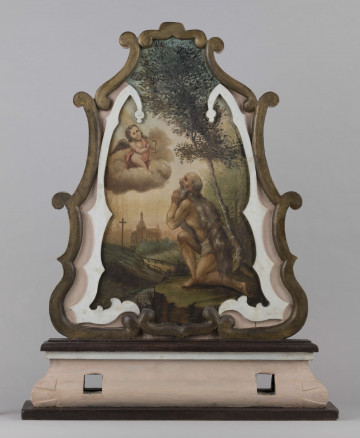
Saint Barbara
1801 — 1900
National Museum in Lublin
Part of the collection: Folk Art of the Lublin Region (17th–1st half of the 20th c.)
The figure of God - creator and lawgiver, residing in the upper, invisible to mortal eyes region of heaven, was considered passive. A more considerable role was assigned to Jesus and Mary and the saints as divine intermediaries. Each patron saint was recognisable by the props, attributes, attached to him, often associated with a life or a form of martyrdom. Their help was sought in times of illness: St Blaise for a sore throat, St Apollonia for teeth, St Lucia for eyes. When faced with incomprehensible events or natural disasters, such as fire, flood or a thunderstorm, one prayed to, in turn, St Florian, St John of God and St John of the Cross: St Florian, St John of Nepomuk and St Barbara.
The cult of St Barbara has always been alive in Poland and has survived until modern times. The first mention of her liturgical remembrance on 4 December was made in the 11th century in the "Prayer Book of Gertruda", the daughter of Mieszko II. She was considered the patroness of dangerous professions (miners, steelworkers, pewter makers, bricklayers, artillerymen) and professions connected with water. Sea fishermen and inland rafters never set sail without the image of the saint, and they asked for protection, abundant catches and a happy return home in their prayers. Near harbours and river harbours chapels were erected in gratitude for the lives saved.
Saint Barbara became the heroine of many church and grandfather songs, as well as proverbs. The December day assigned to her was a time of omens. Since it is the beginning of Advent, there are many proverbs predicting the weather for Christmas: "Saint Barbara on water - Christmas on ice". (and vice versa), "If Barbara walks on water, Christmas walks on ice, and Easter walks on water", "If a goose walks on a pond on St Barbara's Day, it will swim on it on Christmas Day", "When it's cold on St Barbara's Day, winter will be delayed", "When it's cold on St Barbara's Day, winter will be delayed", "When it's cold on St Barbara's Day, winter will be delayed", and "When it's cold on St Barbara's Day, winter will be delayed". There were also sayings of a vegetative nature, for example: "For Barbara it's bright - in farmyards it's tight". St Barbara's Day also marked the end of matrimonial fortune-telling, which had been going on since St Catherine's Day (25 November). If a cherry blossom blossomed on Christmas Day when the girls put it in the water jug, it meant a speedy and happy marriage.
Author / creator
Dimensions
cały obiekt: height: 48 cm, width: 52 cm
Object type
picture
Technique
oil technique
Material
canvas, oil-based paint
Creation time / dating
Creation / finding place
Owner
The National Museum in Lublin
Identification number
Location / status

1801 — 1900
National Museum in Lublin

1801 — 1900
National Museum in Lublin

1864
National Museum in Lublin
DISCOVER this TOPIC
National Museum in Lublin
DISCOVER this PATH
Educational path